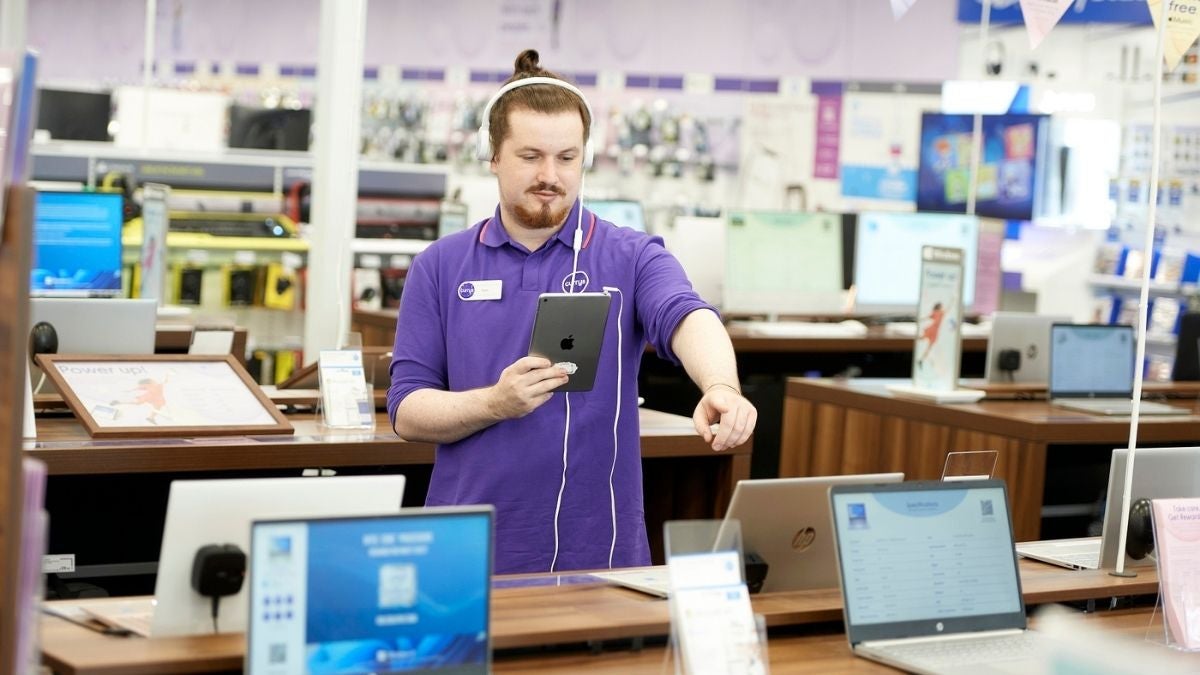
For many bricks-and-mortar stores, the urge to make the switch to ecommerce is ever present.
Over the course of the pandemic, high-street footfall saw a dramatic decline and is yet to recover to pre-Covid levels. Similarly, soaring business rates have meant that some of the country’s most recognisable high-street names have disappeared, only to be replaced by US candy stores.
One company that has so far resisted the pull towards purely online retail is Currys. Its CTO, Arron D’Aubney, recognises that the technology retailer is perhaps best known among UK customers as a traditional bricks-and-mortar business. And he firmly believes that moving solely into ecommerce would have been the wrong move for the company.
“The unique selling point for Currys is our colleagues, who have the ability to help customers choose the technology that’s best for them,” he says. “The technology retail space is getting more confusing and the manufacturers aren’t necessarily making it easier. We want to bridge that gap; to help customers choose the right product for their home.”
If Currys had sacrificed this element of customer service, D’Aubney believes it would have become “no different than any other provider”. Instead, the retailer, which served an average of 8.5 million customers a week over the past three years, has opted to find new ways to integrate the in-store and online shopping experience.
Currys’ digital transformation
From market research, the company found that 60% of its customers prefer to shop across multiple channels rather than on an individual platform. As a result, the retailer explored a number of ways to allow customers to move seamlessly between the online and in-store experience.
“We really wanted to bring out the best of our store network and find a way to combine that with an amazing online experience to create a true ‘omni-channel’ retail experience,” D’Aubney says.
The CTO joined at the start of Currys’ digital transformation project, which began just over two years ago. The mission statement, set by group chief executive Alex Baldock, was to “help customers enjoy amazing technology”.
“We knew digital transformation was going to bring that vision to reality,” D’Aubney says.
One innovation that has emerged from the digital transformation project is a new online feature called Shoplive. The idea was to bring online the expertise that customers can get from shop assistants in-store. When shopping for a product, a button on the bottom of the screen allows shoppers to connect with an expert, via video call, 24 hours a day.
Although the feature came about as a result of the pandemic, D’Aubney claims that it’s now here to stay. He adds: “It fits nicely into our overall vision by making it easier to shop for customers and ensuring that they get the help at the right time, however they choose to shop with us. Believe it or not, people sometimes need assistance at 3am.”
Blending in-store and online
Allowing customers to more easily switch between browsing online and picking up at a bricks-and-mortar store has also been important. Even during the pandemic, D’Aubney claims that many Currys customers opted to collect their technology items in person immediately rather than wait for a delivery.
“The pandemic showed us that customers really value those options and it’s something they want to see more of, hence why we’re evolving that as part of our transformation,” he says. “Not everyone wants to buy a large-screen TV online – they want to do their research, which often starts online, before they then decide to pick it up in-store.”
One method for enhancing this experience has developed through the integration of Salesforce’s Service Cloud, a cloud-based customer service platform that allows staff to browse all of Currys’ products and additional information on each.
D’Aubney adds: “The whole point of the partnership with Salesforce is that it is a true technology company, and they’re innovating in a space that not many retailers operate in, so we’re leveraging that innovation.”
In his opinion, it has allowed Currys to adapt to the “rapidly evolving” retail technology landscape.” We want to make sure that the technology we give our colleagues helps them to assist customers and choose the right product for them,” he says. “It’s not about making people work in a different way; we want the technology to complement what they currently do.”
After supply-chain issues – which D’Aubney says are “not a consideration for us currently” – and reduced consumer demand caused Currys to lower its profit forecast at the start of the year, the retailer hopes that these in-store and online innovations will help encourage customers to spend with them again.

For many bricks-and-mortar stores, the urge to make the switch to ecommerce is ever present.
Over the course of the pandemic, high-street footfall saw a dramatic decline and is yet to recover to pre-Covid levels. Similarly, soaring business rates have meant that some of the country’s most recognisable high-street names have disappeared, only to be replaced by US candy stores.
One company that has so far resisted the pull towards purely online retail is Currys. Its CTO, Arron D'Aubney, recognises that the technology retailer is perhaps best known among UK customers as a traditional bricks-and-mortar business. And he firmly believes that moving solely into ecommerce would have been the wrong move for the company.
